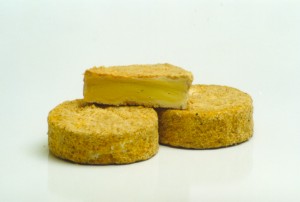
|
|
|||||
Camembert au Calvados is a wonderful combination of two of Normandy's largest exports - Camembert and Calvados. Camembert is relatively young in cheese making terms - a mere 290 years. However this style of soft cheese has been made in Normandy since the 11th century and two other famous and much older cheeses of the area are Pont l'Eveque and Livarot. Neither of these however, have been able to gain such world-wide recognition. It was during the time of the French Revolution that a farmers wife, Marie Harel, and her family gave shelter to a priest from the Brie region. He passed on the cheese making knowledge he had gained from his Brie-making parishioners as a way of repaying the kindness shown to him. The soft cheeses that Marie made improved dramatically becoming softer and fuller-flavoured. She then in turn passed her knowledge onto her daughter who, with her husband, Victor Paynel, sold cheeses in the nearby market of Vimoutiers (excellent farmhouse Camembert cheeses can still be bought in the market of Vimoutiers today). Victor Paynel took advantage of meeting Napoleon III by presenting a Camembert to him. With the royal seal of approval the future of this small cheese was secured. Two later developments must be credited with giving Camembert its ultimate world- wide success. Firstly the invention of the chop-wood box, allowing the cheeses to safely travel long distances across bumpy roads. Cheeses could now mature in transit when covering long distances in Europe or crossing the channel to England. Previously they had been wrapped in paper and straw and barely survived the journey to Paris. The second development was the introduction in 1910 of Penicillium candidium, the snowy-white mould which is sprinkled or sprayed on the surfaces of the cheeses. Camembert is now made in enormous quantities, accounting for almost 20% of all French cheese production. It is also copied all over the world and it has become so widespread that the name of Camembert, like Cheddar, cannot be protected. However, 'Camembert de Normandie' gained its protective AOC status in 1983 and it is this unpasteurised cows' milk farmhouse cheese that we sell at The Teddington Cheese. It is far superior to the factory-made pasteurised versions generally found today. The paste is plump and golden-yellow and the rind is creamy-white. Camembert has a fragrant aroma and a full-flavour. The French usually enjoy their Camembert 'moitié affiné' (semi-mature) when the centre of the cheese is still firm and the outer part is creamy. The British prefer their cheese fully mature with all of the paste matured to a creamy texture. This difference of taste may have been due to the long transit times from France to Britain in the past leading to a much riper cheese being enjoyed on the dinner tables of London. We have preferred the more mature Camembert to this day. Camembert is excellent throughout the year but the very best cheeses are made from spring to autumn when the cows' enjoy the rich grass in the pastures. Camembert can be enjoyed on its own with a glass of Normandy cider or a light red wine. It is also excellent as part of a cheeseboard. Camembert has formed the basis of many recipes and is popular in Britain when coated in bread crumbs, fried and then served with a fruit preserve. Each cheese measures 10cm in diameter, is 3cm deep, weighs 250 grammes and has a fat content of 45%. Click here or press your 'Back' button to return |
|
|||||
| All articles © www.teddingtoncheese.co.uk | ||||||
